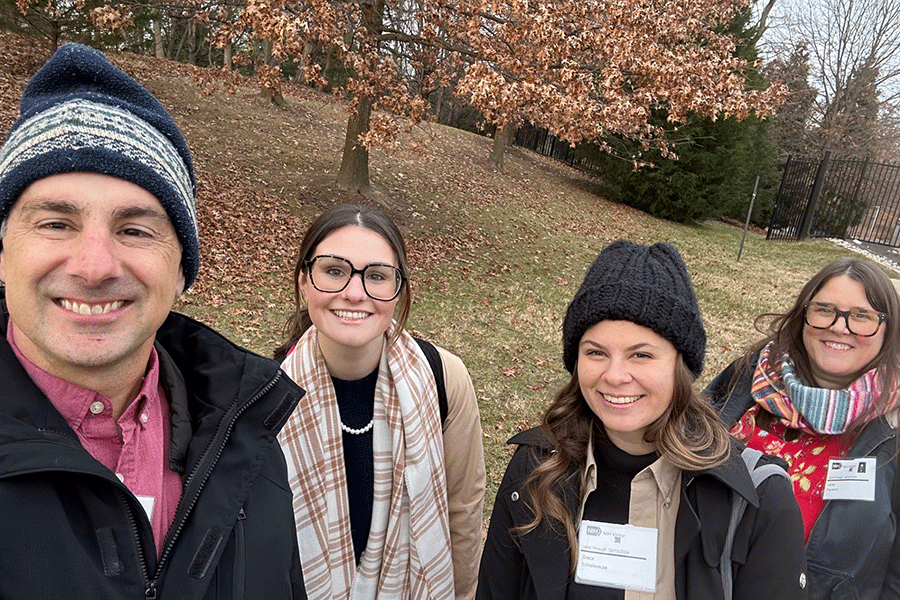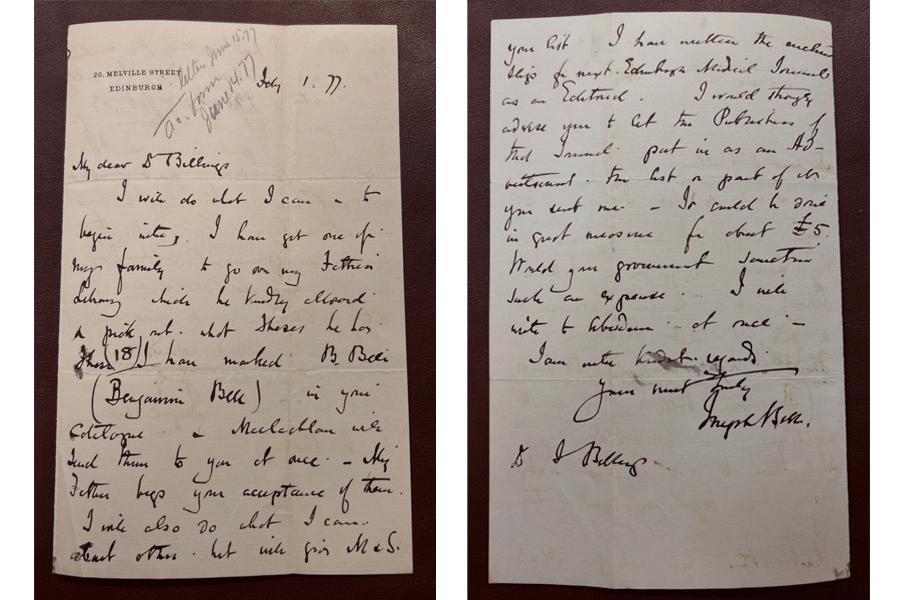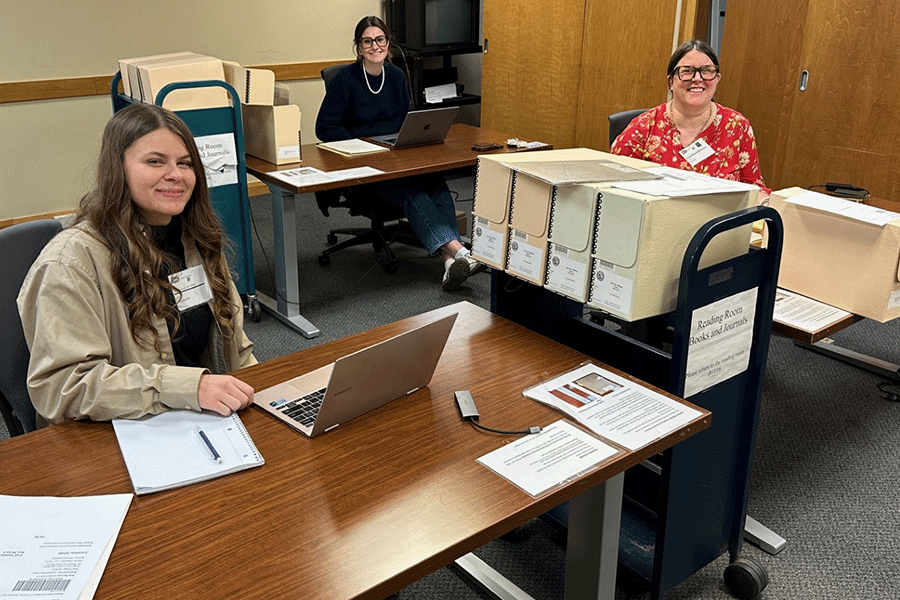Kansas State Students Discover Historical Connections to Public Health and Sherlock Holmes on National Field Trip
A group of inquisitive Kansas State University students recently uncovered remarkable historical artifacts that connect the history of public health to the iconic fictional detective Sherlock Holmes.
As part of the 43rd Frontier Field Trip, a trio of students traveled to the National Library of Medicine (NLM) in Bethesda, Maryland, and Gunston Hall in Virginia during Dec. 12-15, right after their final exams.
Led by Dr. Justin Kastner, professor of food safety and security in the College of Veterinary Medicine, the students — Alexa Heseltine, a dual-degree BS/MPH student; Grace Schieferecke, an undergraduate honors student majoring in biology; and Lesley Hayward, an MPH student — explored the archives of the NLM’s history of medicine collections and captured insights into the evolution of public health and medicine.

Frontier students visit Maryland and Virginia on 43rd Frontier Trip. From left: Dr. Justin Kastner, Alexa Heseltine, Grace Schiefercke and Lesley Hayward.
Alexa discovered a handwritten letter from Dr. Joseph Bell in the archives. Dr. Bell was a 19th century Edinburgh physician and professor who famously inspired Arthur Conan Doyle, then a medical student, to create the character of Sherlock Holmes. The letter, dated Feb. 1, 1877, was addressed to John Shaw Billings, the DC-based founder of the NLM and an early advocate for the “one health” approach to public health; the date and year coincide with Arthur’s first year of medical school, as he began his studies at Bell’s medical school in October 1876. Alexa’s work is part of her undergraduate honors project. She also helps Dr. Kastner create new educational content for future students.
Grace found an equally significant piece of correspondence involving Dr. Robert Koch, the German microbiologist and Nobel Prize laureate regarded as the “Father of Microbiology.” Grace’s research builds on her experiences in UHP 189: Human and Veterinary Public Health in the Age of Sherlock Holmes, a course that introduced students to historical figures such as Arthur Conan Doyle, Dr. Joseph Bell, and Robert Koch. When she found correspondence from Dr. Koch, it was in German, so she had to seek assistance from Dr. Sara Luly, honors program director and associate professor of German. They met, and Dr. Luly was able to translate most of the letter. From Dr. Luly’s translation, Schieferecke found the letter was largely about yellow fever and the innovative thinking of Rudolph Hering, a leader in city design.

Handwritten letter from Dr. Joseph Bell that was found by Alexa Heseltine. The letter was dated from Feb. 1, 1877.
“Historical documents, like the ones we examined in Bethesda, certainly bring to life that sense of discovery, and, importantly, need for new regulatory approaches to the food system, water safety, and veterinary public health,” said Dr. Kastner. “Historical documents connect the present and past through the writings of real people — scientists, veterinarians, physicians, public health practitioners and politicians. Alexa — reading the writings of Dr. Bell — and Grace — reading the writings of Robert Koch — were able to “bridge” today’s One Health and infectious disease practices to two pioneers from the late 19th century.”
“It was incredibly interesting to be able to have hands on such a vital piece of history,” Alexa said. “Having learned about Joseph Bell and John Shaw Billings throughout my undergraduate studies, it was amazing to be able to look at a primary source document of their correspondence. This letter is proof of the lasting efforts to support global public health and is inspirational for continuing my public health career.”
In keeping with previous Frontier Field Trip activities, students were experientially introduced to new ways of thinking across academic disciplines — or “frontiers,” as Dr. Kastner terms them.

Frontier students at the National Library of Medicine in Bethesda, Maryland. From left: Grace Schieferecke, Alexa Heseltine and Lesley Hayward.
“This field trip has allowed me to experience microbiology and medical science through a historical and archival lens, which I haven’t really done before,” Grace said. “Next year, I will be attending the University of Kansas School of Medicine to become a medical doctor, and I will carry these historical experiences throughout my medical career, especially helping me with my goal of staying involved in public health. Learning about these historical One Health leaders opens my perspectives to the crossover between human, animal and environmental health. This perspective is paramount to problems in public health, a hands-on perspective I could only gain through a field trip like this.”
The trip also included a visit to Gunston Hall, the historic plantation of George Mason in Virginia, where Alexa and Grace engaged with 18th-century historical documents, some related to animal diseases of international trade significance. In doing so, Alexa and Dr. Kastner gathered content for one of his other courses that he is redesigning by using video content of primary source documents. At Gunston Hall, they were joined by Dr. Jason Ackleson, a Virginia-based adjust faculty member for K-State and co-director of the Frontier Field Trip program.
The Frontier Field Trip series, now in its 43rd iteration, continues to offer Kansas State students invaluable opportunities to explore historical archives, conduct hands-on research and uncover stories that bridge history, science and literature.
For more information about the Frontier Field Trips, please contact Dr. Kastner at jkastner@k-state.edu.